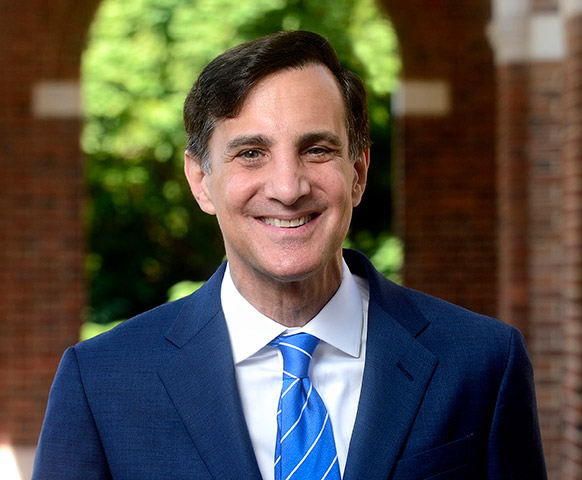
Image caption:
Ronald J. Daniels
President
When I ride Amtrak to and from New York, I pick my seat carefully.
As the train glides through Baltimore, I want a southern view. Through those windows, I have watched the remarkable creation of the city's newest elementary and middle school, Elmer A. Henderson: A Johns Hopkins Partnership School.
From the ground, I kept a close eye on incremental developments—foundation, walls, corridors, classrooms taking shape. But from the train, I witnessed an entire building gracefully unfolding into its East Baltimore community, a trip-by-trip time-lapse view of our progress.
When we opened the doors to the new Henderson-Hopkins building in January, we expected our 368 students to be excited for their first peek at the gym, the music room, and the spacious, airy teaching areas. But we were overwhelmed by their pride—the kindergartner's wonder at being the first to sit in a new chair, the fifth-grader's thrill at sinking the first three-pointer on a new indoor court, the silent line of second-graders marching down the corridor with heads held high.
We expected interest from our parents, who—like me—had watched this building take shape. But we were overwhelmed by their pride, too. On the day the doors opened, Principal Katrina Foster arranged tours for parents, expecting about 25 to show up. Instead, 125 arrived to explore the school, many taking time off from work just to be there on the first day.
Henderson-Hopkins is more than a good, neighborhood public school. It is a tangible representation of Johns Hopkins' commitment to its community, a place where our leadership is helping to shape not only the physical structure of the building but the academic curriculum inside it and the kinds of wraparound family supports that help ensure a child's success. Sitting in the footprint of the 88-acre East Baltimore Development Initiative, this school is also a vital piece of that vast effort to transform the challenged neighborhood beside our medical campus.
Johns Hopkins has a long history of commitment to its East Baltimore neighbors. The Harriet Lane Clinic began treating local children more than a century ago. The Access Partnership provides free specialty care to needy, underinsured or uninsured patients living near our two Baltimore hospitals. Our nurses work throughout the community, and our labs and clinics open their doors to aspiring scientists from nearby Dunbar High School.
But it's hard to overestimate the impact that Henderson-Hopkins will have. It is the cornerstone of our commitment to East Baltimore, a promise that we have made to our neighbors, an investment in the future of the more than 560 children who will soon fill its halls, and an image that I'm proud to display to my fellow south-facing riders on Amtrak's Northeast Corridor line.

Ronald J. Daniels
President







